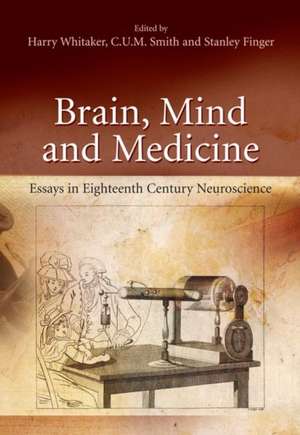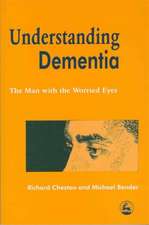Brain, Mind and Medicine:: Essays in Eighteenth-Century Neuroscience
Editat de Harry Whitaker, C. U. M. Smith, Stanley Fingeren Limba Engleză Hardback – 24 sep 2007
| Toate formatele și edițiile | Preț | Express |
|---|---|---|
| Paperback (1) | 953.52 lei 43-57 zile | |
| Springer Us – 3 noi 2010 | 953.52 lei 43-57 zile | |
| Hardback (1) | 963.15 lei 43-57 zile | |
| Springer Us – 24 sep 2007 | 963.15 lei 43-57 zile |
Preț: 963.15 lei
Preț vechi: 1174.58 lei
-18% Nou
Puncte Express: 1445
Preț estimativ în valută:
184.32€ • 191.34$ • 153.69£
184.32€ • 191.34$ • 153.69£
Carte tipărită la comandă
Livrare economică 24 martie-07 aprilie
Preluare comenzi: 021 569.72.76
Specificații
ISBN-13: 9780387709666
ISBN-10: 0387709665
Pagini: 376
Ilustrații: XIII, 376 p.
Dimensiuni: 178 x 254 x 25 mm
Greutate: 0.95 kg
Ediția:2007
Editura: Springer Us
Colecția Springer
Locul publicării:New York, NY, United States
ISBN-10: 0387709665
Pagini: 376
Ilustrații: XIII, 376 p.
Dimensiuni: 178 x 254 x 25 mm
Greutate: 0.95 kg
Ediția:2007
Editura: Springer Us
Colecția Springer
Locul publicării:New York, NY, United States
Public țintă
Professional/practitionerCuprins
Introduction.- Chronology.- Background: Introduction.- Brain and Mind in the ‘Long’ 18th Century.- Enlightening Neuroscience: Microscopes and Microscopy n the Eighteen Century.- Corpus Curricula: Medical Education and the Voluntary Hospital Movement.- Some Thoughts on the Medical Milieu in the Last Quarter of the Eighteenth Century as Reflected in the Life and Activities of James Parkinson (1755-1824).- The Nervous System: Introduction.- John Hunter’s Contributions to Neuroscience.- Cullen and Whytt on the Nervous System.- 1710: The Introduction of Experimental Nervous System Physiology and Anatomy by François Pourfour du Petit.- Irritable Glue: The Haller-Whytt Controversy on the Mechanism of Muscle Contraction.- The Taming of the Electric Ray: From a Wonderful and Dreadful ‘Art’ to ‘Animal Electricity’ and Electric Battery.- Luigi Galvani, Physician, Surgeon, Physicist: From Animal Electricity to Electrophysiology.- Brain and Behavior: Introduction.- The Vision of William Porterfield – David Hartley’s Neural Vibrations and Psychological Associations.- Charles Bonnet’s Neurophilosophy.- Swedenborg and Localization Theory.- Medical Theories and Applications: Introduction.- Neuroscience in the Work of Boerhaave and Haller.- Apoplexy-Changing Concepts in the Eighteenth Century.- Benjamin Franklin and the Electrical Cure for Disorders of the Nervous System.- Gentleman’s Magazine, the Advent of Medical Electricity, and Disorders of the Nervous System.- Therapeutic Attractions: Early Applications of Electricity to the Art of Healing.- John Wesley on the Estimation and Cure of Nervous Disorders.- Franz Anton Mesmer and the Rise and Fall of Animal Magnetism: Dramatic Cures, Controversy, and Ultimately a Triumph for the Scientific Method.- Hysteria in the Eighteenth Century.- Cultural Consequences: Introduction.- Technological Metaphors and the Anatomy of Representations in Eighteenth Century French Materialism andDualist Mechanism.- Explorations of the Brain, Mind and Medicine in the Writings of Jonathan Swift.- Temperament and the Long Shadow of Nerves in the Eigthteenth Century.- Index.
Recenzii
From the reviews:
"An attempt at understanding questions of body and mind based on questions shaped by the philosophical premises of the time. … this volume provides a comprehensive set of works outlining major issues of the long 18th century and appears set to become an excellent reference book. … will have special appeal to anyone interested in the history of neuroscience, neurology, psychology, and medicine, as well as serving as a valuable resource for the contemporary neuroscientist and psychologist interested in the basis of current thinking." (Simon Boag, PsycCRITIQUES, Vol. 53 (26), 2008)
"Brain, Mind, and Medicine is well written, nicely illustrated and has its uses. It will appeal to physicians and historians of the neurosciences, and may have some use within undergraduate teaching." (Stephen Casper, History of Psychiatry, Vol. 20 (1), 2009)
"An attempt at understanding questions of body and mind based on questions shaped by the philosophical premises of the time. … this volume provides a comprehensive set of works outlining major issues of the long 18th century and appears set to become an excellent reference book. … will have special appeal to anyone interested in the history of neuroscience, neurology, psychology, and medicine, as well as serving as a valuable resource for the contemporary neuroscientist and psychologist interested in the basis of current thinking." (Simon Boag, PsycCRITIQUES, Vol. 53 (26), 2008)
"Brain, Mind, and Medicine is well written, nicely illustrated and has its uses. It will appeal to physicians and historians of the neurosciences, and may have some use within undergraduate teaching." (Stephen Casper, History of Psychiatry, Vol. 20 (1), 2009)
Textul de pe ultima copertă
Ideas we associate with the 18th century are clearly seen in work published from the latter decades of the 17th century through the first decades of the 19th century. This is the "long 18th century", a period which exhibits multiple discourses in medicine, brain science and philosophy. The editors have deliberately adopted a "presentist" subtitle, "neuroscience", to emphasize that this collection of essays reflect a range of current thought about 18th century-studies of the nervous system in isolation and in context. There are six sections, each preceded by a short introduction.
The opening section of Brain, Mind and Medicine: Neuroscience in the 18th Century sets forth a temporal chronology for the long 18th century. This is followed by a background section of essays on (a) brain and mind in the long 18th century, (b) the role of microscopes and microscopy in this period, (c) the nature of 18th century medical education and the place of voluntary hospitals and (d) an illustration of late-18th century medicine, discussing the early career of James Parkinson as an example.
The third section contains a series of papers focusing on the nervous system, with (a) an exegesis of John Hunter’s work, (b) the contributions of William Cullen and Robert Whytt, (c) a detailed analysis of the physiological and anatomical work of Pourfour du Petit, (d) the debate between Albrecht Haller and Robert Whytt concerning the mechanism of muscle contraction and two essays on developments in animal electricity during this epoch, (e) the early history starting with observations of the electric ray, and (f) the later contributions of Luigi Galvani, medical man and scientist.
The fourth section on brain and behavior considers (a) William Porterfield’s thoughts on vision, and three essays in speculative philosophy of neuroscience, (b) a discussion of David Hartley’s vibration theory, (c) a discussion of Charles Bonnet’s vibration theory and an analysis of Emanuel Swedenborg’s century-too-soon thoughts on localization of brain function.
The next section opens with an essay (a) on the neuroscientific ideas of Hermann Boerhaave and Albrecht Haller, then (b) a discussion of the evolution of our understanding of strokes in this epoch; these are followed by three essays on the development and applications of medical electricity, the first (c) on the contribution of Benjamin Franklin, the second (d) on how medical electricity was discussed in the popular publication, Gentleman’s Magazine, and the third (e) on the application of medical electricity in physician’s practices. The essays continue with (f) the medical opinions of the clergyman John Wesley, followed by (g) an essay on the best example of the power of suggestion in this era, Franz Anton Mesmer’s notions of animal magnetism. The final essay in this section (h) discusses the evolution of the concept of hysteria well in advance of the well-known work of Jean Marie Charcot and Sigmund Freud.
The final three essays in the last section capture some of the cultural consequences of 18th century interest in the nervous system: (a) in the context of French materialism, (b) in Jonathan Swift’s literary treatment of brain and nervous system and, finally (c) in an analysis of the origin and development of the concept of temperament.
Cover illustration: A young woman being treated with medical electricity in the 18th century. (From Adams, 1785; see chapter by Bertucci.)
The opening section of Brain, Mind and Medicine: Neuroscience in the 18th Century sets forth a temporal chronology for the long 18th century. This is followed by a background section of essays on (a) brain and mind in the long 18th century, (b) the role of microscopes and microscopy in this period, (c) the nature of 18th century medical education and the place of voluntary hospitals and (d) an illustration of late-18th century medicine, discussing the early career of James Parkinson as an example.
The third section contains a series of papers focusing on the nervous system, with (a) an exegesis of John Hunter’s work, (b) the contributions of William Cullen and Robert Whytt, (c) a detailed analysis of the physiological and anatomical work of Pourfour du Petit, (d) the debate between Albrecht Haller and Robert Whytt concerning the mechanism of muscle contraction and two essays on developments in animal electricity during this epoch, (e) the early history starting with observations of the electric ray, and (f) the later contributions of Luigi Galvani, medical man and scientist.
The fourth section on brain and behavior considers (a) William Porterfield’s thoughts on vision, and three essays in speculative philosophy of neuroscience, (b) a discussion of David Hartley’s vibration theory, (c) a discussion of Charles Bonnet’s vibration theory and an analysis of Emanuel Swedenborg’s century-too-soon thoughts on localization of brain function.
The next section opens with an essay (a) on the neuroscientific ideas of Hermann Boerhaave and Albrecht Haller, then (b) a discussion of the evolution of our understanding of strokes in this epoch; these are followed by three essays on the development and applications of medical electricity, the first (c) on the contribution of Benjamin Franklin, the second (d) on how medical electricity was discussed in the popular publication, Gentleman’s Magazine, and the third (e) on the application of medical electricity in physician’s practices. The essays continue with (f) the medical opinions of the clergyman John Wesley, followed by (g) an essay on the best example of the power of suggestion in this era, Franz Anton Mesmer’s notions of animal magnetism. The final essay in this section (h) discusses the evolution of the concept of hysteria well in advance of the well-known work of Jean Marie Charcot and Sigmund Freud.
The final three essays in the last section capture some of the cultural consequences of 18th century interest in the nervous system: (a) in the context of French materialism, (b) in Jonathan Swift’s literary treatment of brain and nervous system and, finally (c) in an analysis of the origin and development of the concept of temperament.
Cover illustration: A young woman being treated with medical electricity in the 18th century. (From Adams, 1785; see chapter by Bertucci.)
Caracteristici
Only volume dedicated to all aspects of 18th century neuroscience
Includes supplementary material: sn.pub/extras
Includes supplementary material: sn.pub/extras












